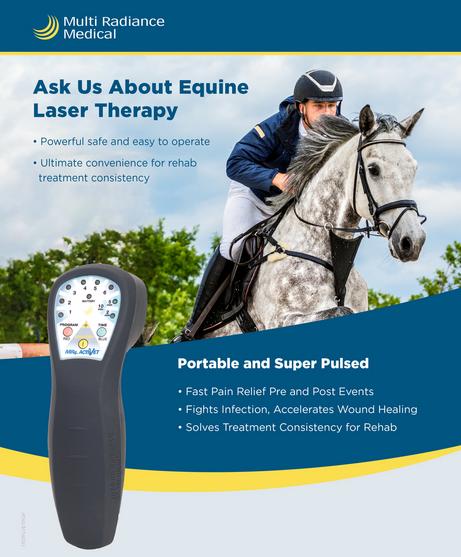Discover the Remarkable Advantages of Equine Therapy for Emotional Healing
Discover the Remarkable Advantages of Equine Therapy for Emotional Healing
Blog Article
How Laser Treatment in Equine Therapy Is Transforming Vet Care for Equines
Laser treatment has actually arised as a transformative strategy in equine vet treatment, providing a non-invasive solution that speeds up healing and improves general health and wellness. The mobility and adaptability of laser treatment gadgets additionally highlight their expanding necessity among veterinarians.

Recognizing Laser Therapy
Recognizing laser treatment is vital for appreciating its role in equine therapy. Laser therapy, additionally called photobiomodulation, involves the application of particular wavelengths of light to cells, which can result in numerous organic results. This therapeutic method uses the power of light energy to penetrate the skin and underlying tissues, promoting cellular processes and boosting tissue repair work.
The modern technology behind laser treatment is based in the principle of photochemistry, where photons are soaked up by chromophores within cells, bring about enhanced ATP manufacturing and inflection of reactive oxygen varieties. This, in turn, advertises mobile expansion, minimizes inflammation, and increases healing. Veterinary practitioners use various types of lasers, consisting of low-level lasers (LLLT) and high-power Class IV lasers, depending on the particular healing objectives and the nature of the equine problem being dealt with.
Different laser wavelengths and power setups are carefully chosen to target various cells midsts and accomplish desired medical outcomes. Safety protocols are critical, as inappropriate usage can cause thermal damages or suboptimal therapeutic effects. Therefore, a detailed understanding of laser treatment's systems and applications is critical for its reliable implementation in equine vet practice.
Advantages for Horse Health
The myriad benefits of laser treatment for equine wellness encompass enhanced recovery, discomfort decrease, and boosted flexibility. This innovative therapy modality leverages details wavelengths of light to pass through tissues, promoting cellular feature and promoting rapid cells repair service. The non-invasive nature of laser therapy ensures minimal anxiety and discomfort for the horse, promoting a smoother recuperation process.

Enhanced flexibility is one more crucial advantage, particularly for efficiency and functioning steeds. By reducing swelling and discomfort, and improving cells fixing, laser treatment assists in bring back joint function and muscular tissue flexibility. The collective effect of these benefits is not just a quicker go back to typical activity however also a general enhancement in the equine's lifestyle. Therefore, laser treatment stands as a transformative tool in contemporary horse veterinary care.
Common Conditions Treated
Laser treatment has arised as a versatile treatment choice for a variety of typical equine conditions. In addition, laser therapy is reliable for problems like osteoarthritis, where it aids reduce joint inflammation and advertise cells repair service.
Wound management is one more area find more where laser therapy has actually shown significant assurance. Persistent wounds or slow-healing abscess can be especially difficult in equines, yet laser therapy improves mobile regrowth and boosts blood flow, hence expediting the healing procedure. Laser therapies have actually been effectively utilized in managing unguis problems such as laminitis and abscesses, easing pain and promoting much faster recuperation.
Horse athletes often endure from performance-related concerns like muscle mass soreness and tension fractures. Laser therapy help in decreasing muscle exhaustion and expedites the recuperation of micro-injuries, thus guaranteeing that steeds go back to come to a head efficiency a lot more rapidly. By addressing these varied conditions, laser treatment is transforming the landscape of vet care, providing a non-invasive, reliable alternative to traditional therapies.
Technology Behind Laser Treatment

Laser tools used in veterinary medication usually utilize low-level laser therapy (LLLT) or chilly laser treatment. Unlike high-powered medical lasers, these tools operate at lower energy degrees, maximizing healing benefits while reducing thermal damages. The power from the laser light boosts adenosine triphosphate (ATP) production, enhances cellular metabolic process, and increases cells repair processes.
Modern laser therapy devices for equine therapy is made with flexible setups to deal with the specific needs of different tissues and conditions. Equine Therapy. Specifications such as wavelength, power thickness, and therapy period can be carefully tuned, offering tailored therapeutic services. Furthermore, innovations in laser technology have i was reading this brought about the development of portable, handheld devices, making it much easier for vets to provide treatment in a variety of setups, from facilities to stables. This technical advancement is a foundation in the revolutionizing of equine veterinary treatment.
Success Stories and Instance Researches
Showcasing the concrete benefits of laser treatment, various success stories and instance research studies illuminate its transformative influence on equine health and wellness. One such case entails a pureblood racehorse suffering from persistent tendonitis. Standard treatments produced very little renovation, however after integrating laser treatment into the program, the horse showed significant decreases in inflammation and discomfort within weeks, ultimately going back to competitive auto racing.
Another compelling instance includes a dressage horse diagnosed with serious pain in the back, limiting its performance. A vet group employed low-level laser therapy (LLLT) to target the swollen locations, resulting in marked renovation in flexibility and a significant decline in discomfort. Over several sessions, the horse restored its peak kind, showcasing the efficiency of laser therapy in dealing with musculoskeletal problems.
Furthermore, a research performed at a leading equine facility examined 50 equines with different soft tissue injuries treated with laser therapy. The outcomes stood out: 85% of the equines showed increased recovery times and boosted mobility. These cases underscore the versatility and effectiveness of laser therapy in equine medicine, providing a non-invasive, scientifically-backed method to improving recuperation and performance in equines.
Final Thought
Laser therapy is transforming equine veterinary care by providing a non-invasive treatment that accelerates recovery, reduces inflammation, and minimizes pain. With its efficiency in dealing with a series of problems, from bone and joint injuries to persistent disorders like you could check here osteoarthritis, this modern technology considerably enhances equine health and mobility. The transportability and adaptability of laser therapy better highlight its transformative effect on veterinary practices, strengthening its role as an important device in contemporary equine healthcare.
Report this page